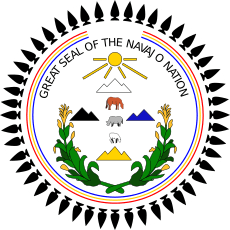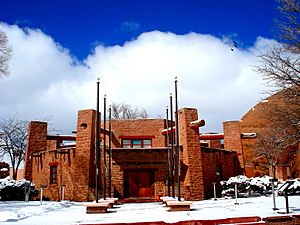Navajo Nation Council facts for kids
Quick facts for kids 24th Navajo Nation CouncilBéésh bąąh dah siʼání |
|
|---|---|
 |
|
| Leadership | |
|
Seth Damon
|
|
| Seats | 24 Delegates |
| Elections | |
|
Last election
|
November 6, 2018 |
|
Next election
|
November 6, 2022 |
| Meeting place | |
 |
|
| Navajo Nation Council Chamber | |
| Website | |
| http://www.navajonationcouncil.org/ | |
The Navajo Nation Council (Navajo: Béésh bąąh dah siʼání) is like the law-making group for the Navajo Nation government. They meet four times a year, plus extra special meetings, at the Navajo Nation Council Chamber in Window Rock, Arizona.
The council has 24 members, called delegates or councilors. These members are chosen by a direct vote. They represent 110 local chapters across Arizona, New Mexico, and Utah. To be a delegate, you must be a member of the Navajo Nation and at least 25 years old. Their offices are in Window Rock, where the Navajo government is located.
The council members choose one of their own to be the Speaker of the Council. The Speaker leads the council's daily work for a two-year term.
Contents
Understanding the Council's Role
The Navajo Nation Council is the main part of the government's law-making side. It includes the council itself and any groups it creates. The council's powers can only be changed if most registered Navajo voters agree in a special vote.
How the Council Works
The Navajo Nation Council holds all powers that are not given to other parts of the government. It also watches over the powers that are given out. The council can set rules for its members and for how its meetings and committees work. It also approves the leaders of different government departments. The council creates special committees and gives them tasks as needed.
Who Takes Over if Leaders are Away?
If the President and Vice President of the Navajo Nation are not able to do their jobs, the Speaker of the Council steps in as President. The Speaker then does both jobs until a new election can be held.
Meet the 24th Council Delegates
On January 16, 2019, the delegates for the 24th Navajo Nation Council officially started their jobs. They also chose Seth Damon to be their Speaker.
| Delegate | Chapter |
|---|---|
| Elmer Begay | Dilcon, Indian Wells, Teesto, Whitecone, Greasewood Springs |
| Kee Allen Begay, Jr. | Tachee/Blue Gap, Many Farms, Nazlini, Tselani/Cottonwood, Low Mountain |
| Paul Begay | Coppermine, K'aii'to, LeChee, Tonalea/Red Lake, Bodaway/Gap |
| Nathaniel Brown | Chilchinbeto, Dennehotso, Kayenta |
| Eugenia Charles-Newton | Shiprock |
| Amber Kanazbah Crotty | Cove, Toadlena/Two Grey Hills, Red Valley Tse'alnaozt'i'i', Sheepsprings, Beclabito, Gadiiahi/To'Koi |
| Seth Damon | Baahaali, Chi Chil Tah, Manuelito, Red Rock, Rock Springs, Tsayatoh |
| Herman Daniels, Jr. | Tsah Bii Kin, Navajo Mountain, Shonto, Oljato |
| Mark Freeland | Becenti, Lake Valley, Nahodishgish, Standing Rock, Whiterock, Huerfano, Nageezi, Crownpoint |
| Pernell Halona | Coyote Canyon, Mexican Springs, Naschitti, Tohatchi, Bahastl'a'a' |
| Jamie Henio | Alamo, Ramah, Tohajiilee |
| Vince R. James | Jeddito, Cornfields, Ganado, Kinlichee, Steamboat |
| Rickie Nez | T'iistoh Sikaad, Nenahnezad, Upper Fruitland, Tse' Daa' Kaan, Newcomb, San Juan |
| Carl Slater | Lukachukai, Round Rock, Tsaile/Wheatfields, Tse Ch'izhi/Rough Rock, Rock Point |
| Raymond Smith, Jr. | Klagetoh, Wide Ruins, Houck, Lupton, Nahata Dziil |
| Wilson Stewart, Jr. | Crystal, Fort Defiance, Red Lake, Sawmill |
| Charlaine Tso | Mexican Water, To'likan, Teesnospos, Aneth, Red Mesa |
| Daniel Tso | Littlewater, Pueblo Pintado, Torreon, Whitehorse Lake, Baca/Brewitt, Casamero Lake, Ojo Encino, Counselor |
| Eugene Tso | Chinle |
| Otto Tso | To' Nanees Dizi |
| Thomas Walker, Jr. | Cameron, Coalmine Canyon, Birdsprings, Leupp, Tolani Lake |
| Edison Wauneka | Oaksprings, St. Michaels |
| Edmund Yazzie | Churchrock, Iyanbito, Mariano Lake, Pinedale, Smith Lake, Thoreau |
| Jimmy Yellowhair | Hard Rock, Forest Lake, Pinon, Black Mesa, Whippoorwill |
Council Committees
The 24th Navajo Nation Council has several committees and subcommittees. These groups help the council do its work more smoothly.
Standing Committees
- Navajo Nation Council
- Naabik’íyáti’ Committee
- Budget and Finance Committee
- Health, Education and Human Services Committee
- Law and Order Committee
- Resources and Development Committee
Subcommittees
- Diné Bizaad Subcommittee
- Gaming Subcommittee
- Navajo–Hopi Land Commission
- Navajo Indian Irrigation Project Subcommittee
- Navajo Assault Prevention Subcommittee
- Quadrilateral Agreement Task Force
- State Task Force Subcommittee
- Title II Reform Subcommittee
Traditional Gatherings: Naachʼid
Long ago, the Diné (Navajo people) had special gatherings called Naachʼid. These meetings happened every 2 to 4 years, or when there was an emergency.
The traditional Navajo government was based on ideas of caring and protecting. Each Navajo clan chose two people to go to these meetings. Their job was to protect and care for the Diné. A person chosen for this council was called naalchʼid. The Hashkééjí Naatʼááh, or war chief, kept the people safe. The Hózhǫ́ǫ́jí Naatʼááh, or peace chief, helped everyone live with kʼé (peace and friendship).
From 1922 to the 15th Council
The Navajo Business Council was started in 1922. The U.S. government created it to approve agreements for minerals on the Navajo land. At its first meeting, the Council agreed to let oil companies use the land. In return, the Navajo Nation was promised more land for farming and raising sheep. Henry Chee Dodge led this first council. It had one member elected from each of five areas, plus an alternate.
In 1937, the Navajo Tribal Council was formed again. This happened after they chose not to accept a U.S. government plan called the Indian Reorganization Act in 1934. Navajo voters later said no to three tries at setting up a new government. They disagreed on the legal rules.
Until 1984, the Navajo Tribal Council was supported by money from the natural resources on the reservation. In 1984, the council created the Permanent Trust Fund. Each year, 12% of all money earned would go into this fund. The money from this fund became available in 2004.
The 16th Council (1987–1990)
The name Navajo Nation Council began to be used around 1989. This change happened with the Title II Amendments of 1989. These changes created the three-part government system used today in Window Rock. This clearly separated the powers of the President and the council. It also created the jobs of Speaker of the Council and Speaker Pro Tem.
Later Councils
17th Council (1991–1994)
The 17th council started its work in 1991.
18th Council (1995–1998)
The 18th council began in January 1995.
19th Council (1999–2002)
The 19th council started in January 1999. In 2001, the council approved a plan with OnSat, an internet company. OnSat was to provide internet service to the 110 chapters.
20th Council (2003–2006)
The 20th council started in January 2003. Lawrence T. Morgan was chosen as Speaker of the Council.
Mid-term
In 2005, Speaker Lawrence T. Morgan was chosen for his second term as Speaker. The Permanent Trust Fund, which was started in 1984, became ready to use during this time.
21st Council (2007–2010)
The 21st council started in January 2007. Speaker Lawrence T. Morgan was chosen for a third term.
2008
On April 29, 2008, Navajo Nation President Joe Shirley Jr. suggested making the Navajo Council smaller. He proposed reducing it from 88 members to 24 members. This change would happen in 2011.
Mid-term
In January 2009, Speaker Morgan was chosen again for a fourth term. This made him the first Speaker to serve eight years in the modern history of the Council. President Shirley spoke to the Council in January 2009. He talked about needing a new governing document for the Navajo Nation.
In a special election on December 15, 2009, tribal members voted to reduce the Navajo Nation Council to 24 members. They also voted to allow the President of the Navajo Nation to reject parts of a bill.
2010
In January 2010, Council Delegate Jonnathan Nez announced changes to the Navajo Nation Code. These changes were made because the tribe voted to make the council smaller. In May 2010, the Navajo Nation Supreme Court ordered that a new plan for council districts be put into place right away.
22nd Council (2011–2014)
On January 11, 2011, the new, smaller 24-member council began its work. The legislative branch started to be reorganized. On January 24, 2011, Delegate Johnny Naize was chosen as Speaker.
In May 2011, President Ben Shelly signed a council resolution. This resolution changed parts of the Navajo Code. One of the changes was to reorganize the committees to fit the new 24-member council.
Mid-term
In January 2013, the council chose Speaker Naize for a second term. Speaker Naize later resigned from his delegate seat in September 2014. Delegate David L. Tom also resigned in October 2014.
In October 2014, the Council voted on a new law to change the language requirement for the president. President Shelly later rejected this bill. In January 2015, the Council met to discuss holding primary elections in June 2015 and general elections in August 2015. President Shelly also rejected this bill.
23rd Council (2015–2018)
The new 23rd Navajo Nation Council officially started on January 13, 2015. After this, the delegates met to choose a speaker pro tem. This person would serve until a Speaker was chosen for a two-year term. Council delegate Kee Allen Begay, Jr. was chosen as speaker pro tem. He served until January 26, 2015. After that, LoRenzo Bates became the Speaker.
24th Council (2019–)
On January 15, 2019, the 24th Navajo Nation Council members took their oath of office. After this, they met to choose a speaker pro tem. Council Delegate Seth Damon was chosen for this role. On January 28, 2019, Seth Damon was voted in as Speaker of the 24th Navajo Nation Council.
In July 2019, Delegate Nelson BeGaye resigned because of health reasons. After a special election, Carl Roessel Slater was elected to fill the seat.
| Name | Chapter | Took office | Left office |
|---|---|---|---|
| Nelson Gorman Jr. | Chinle | 1995 | 1997 |
| Kelsey A. Begaye | Kaibito | 1997 | 1999 |
| Edward T. Begay | Church Rock | 1999 | 2003 |
| Lawrence T. Morgan | Pinedale | 2003 | 2011 |
| Johnny Naize | 2011 | September 2014 | |
| LoRenzo Bates | 2014 | 2015 | |
| Kee Allen Begay Jr. | January 15, 2015 | January 26, 2015 | |
| Lorenzo Bates | January 26, 2015 | January 28, 2019 | |
| Seth Damon | January 28, 2019 | Present |
Notable Delegates
- Annie Dodge Wauneka (Klagetoh, Wide Ruins)
- Rex Lee Jim (Rock Point) 8th Vice President of the Navajo Nation.
- Thomas Dodge 3rd Chairman of the Navajo Tribal Council.
- Amos Frank Singer (Kaibeto) Designer of Navajo Nation Seal
- Kenneth Maryboy (Aneth/Red Mesa/Mexican Water/Sweet Water/ TeecNosPos)
- Davis Filfred (Aneth/Red Mesa/Mexican Water)
- Young Jeff Tom (Mariano Lake/Smith Lake)
- Lorenzo Bates (Upper Fruitland)
- Larry Anderson Sr. (Fort Defiance)
- George Arthur (San Juan, Burnham, Nahenezad)
- Ray Berchman (St. Michael/Oaksprings)
- Ervin Keeswood (Tse Daakaan)
- Hope MacDonald-Lonetree (Tuba City/Coalmine Canyon)
- Johnny Naize (Tselani/Cottonwood/Nazlini)
- Harold Wauneka (Fort Defiance)
- Hoskie Cronemeyer (Houck/Lupton)
- Katherine Benally (Dennehotso)
- Mark Maryboy (Aneth/Red Mesa/Mexican Water)
- Walter Phelps (Birdsprings/Leupp) 2006 Navajo Nation Vice Presidential Candidate.
Images for kids
-
Council Delegate Kenneth Maryboy at a rally (2010).




